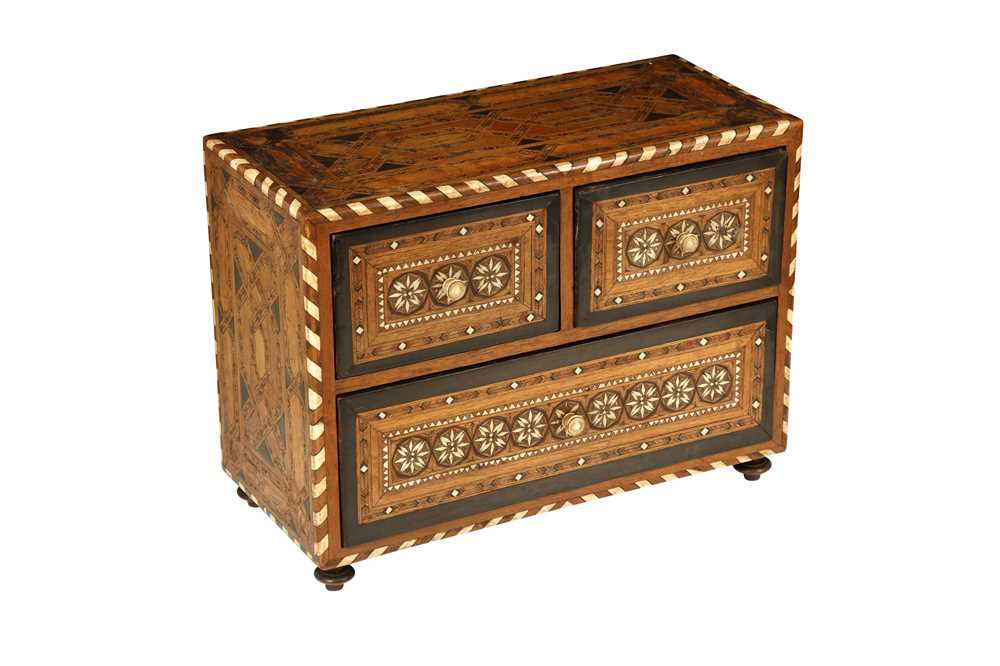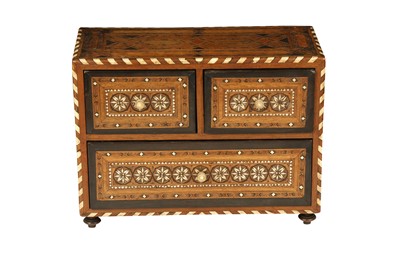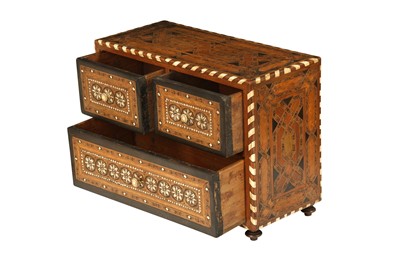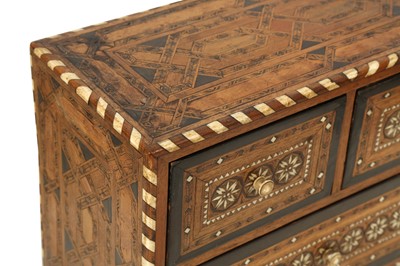3rd Nov, 2021 11:00
A Middle Eastern Journey
λ AN IVORY, STAINED WOOD AND BONE-INLAID HARDWOOD CABINET
Nasrid or Post-Nasrid Spain, 15th - 16th century
λ AN IVORY, STAINED WOOD AND BONE-INLAID HARDWOOD CABINET
Nasrid or Post-Nasrid Spain, 15th - 16th century
Of typical rectangular shape, resting on four squat bulbous feet, the front with three rectangular drawers, the exterior clad in fine marquetry work arranged in symmetrical order in the typical style of Islamic Spain with taracea granadina, comprising tesserae of bone, ivory, silver studs and coloured wood inlaid in a geometric star pattern framed within narrow two-tone fretwork and chevron bands, the back with a large geometric stellar design outlined by interlocking two-tone chevron bands following Nasrid models, 24cm x 32cm x 14cm.
The Spanish word taracea (marquetry), deriving from the Arabic word tarsi (to insert/inlay), describes a technique that consists of inlaying pieces of wood, bone or mother-of-pearl into a piece of hardwood, such as walnut. Material evidence confirms that this technique of Eastern origin was widely in use in Islamic Cordoba since at least the 10th century, but it wasn't until the Nasrid period (1232 - 1492) that it reached its full potential. Indeed, under the Nasrids, the technique was to simplified the elaborate geometrically-cut inlays were attached to a base of paper or parchment, and subsequently placed onto the main piece of furniture (Margarita Sánchez Llorente "Writing desk" in Discover Islamic Art, Museum With No Frontiers, 2021. http://islamicart.museumwnf.org/database_item.php?id=object;ISL;es;Mus01;25;en, last accessed 30/09/2021).
Differently from typical 15th-century Nasrid cabinets and pieces of furniture, our lot shows the presence of tiny silver sections in the marquetry work. In the immediate post-Nasrid period (16th century), the introduction of silver into the taracea became more common thanks to the abundance of that material imported from the Spanish colonies in the New World (M. Rosser-Owen, Islamic Arts from Spain, Victoria and Albert Museum, London, 2010, p.88). Moreover, the designs of 16th-century productions tend to abandon the crisp geometric quality of 15th-century models in favour of more intricate and multi-layered patterns, as evident in the stellar medallions on the front of our cabinet. Another Spanish cabinet related to ours and coming from the same UK-based collection was successfully sold at Sotheby's London earlier this year, 31 March 2021, lot 88.
This item may require Export or CITES licences in order to leave the UK or the European Union. It is the buyer's responsibility to ensure that lots have the relevant licences before shipping.
Do you have an item similar to the item above? If so please click the link below to submit a free online valuation request through our website.










